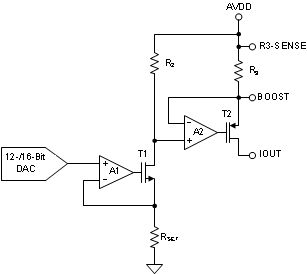ZHCSC70D December 2013 – December 2021 DAC7750 , DAC8750
PRODUCTION DATA
- 1 特性
- 2 应用
- 3 说明
- 4 Revision History
- 5 Device Comparison Table
- 6 Pin Configuration and Functions
- 7 Specifications
- 8 Detailed Description
- 9 Application and Implementation
- 10Power Supply Recommendations
- 11Layout
- 12Device and Documentation Support
- 13Mechanical, Packaging, and Orderable Information
封装选项
机械数据 (封装 | 引脚)
散热焊盘机械数据 (封装 | 引脚)
订购信息
8.3.2 Current Output Stage
The current output stage consists of a preconditioner and a current source, as shown in Figure 8-2. This stage provides a current output according to the DAC code. The output range can be programmed as 0 mA to 20 mA, 0 mA to 24 mA, or 4 mA to 20 mA. Use an external transistor to reduce the power dissipation of the device. The maximum compliance voltage on IOUT equals (AVDD – 2 V). In single power-supply mode, the maximum AVDD is 36 V, and the maximum compliance voltage is 34 V. After power on, the IOUT pin is in a Hi-Z state.
 Figure 8-2 Current Output
Figure 8-2 Current OutputFor a 5-V reference, the output can be expressed as shown in Equation 1 through Equation 3.
For a 0-mA to 20-mA output range, use Equation 1.

For a 0-mA to 24-mA output range, use Equation 2.

For a 4-mA to 20-mA output range, use Equation 3.

where
- CODE is the decimal equivalent of the code loaded to the DAC
- N is the bits of resolution; 16 for DAC8750, and 12 for DAC7750
The current-output range is normally set according to the value of the RANGE bits in the Control Register (see Section 8.4.1 for more details).